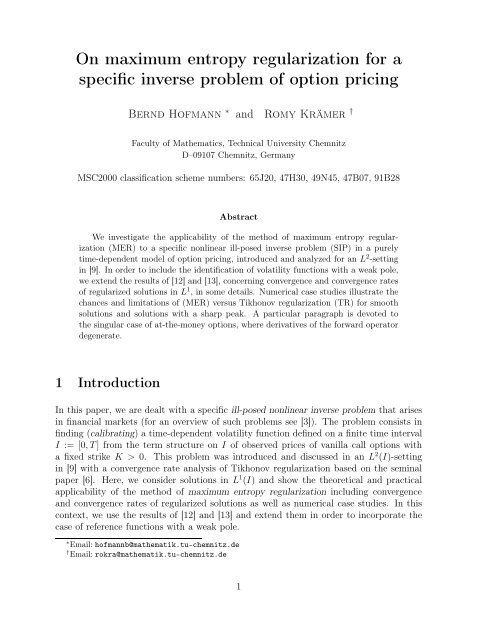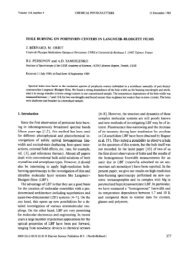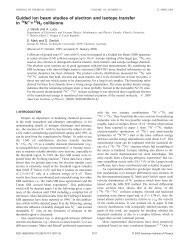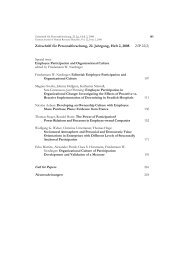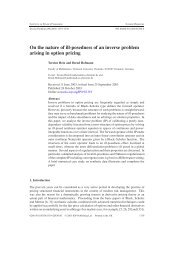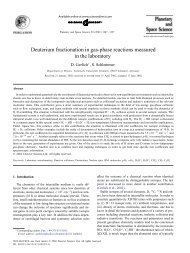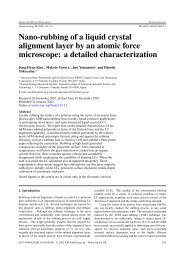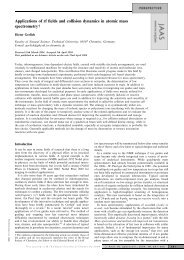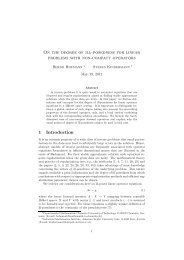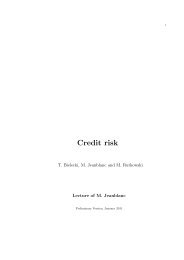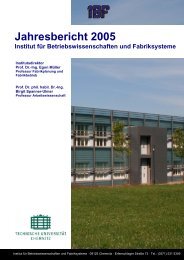On maximum entropy regularization for a specific inverse problem of ...
On maximum entropy regularization for a specific inverse problem of ...
On maximum entropy regularization for a specific inverse problem of ...
You also want an ePaper? Increase the reach of your titles
YUMPU automatically turns print PDFs into web optimized ePapers that Google loves.
<strong>On</strong> <strong>maximum</strong> <strong>entropy</strong> <strong>regularization</strong> <strong>for</strong> a<br />
<strong>specific</strong> <strong>inverse</strong> <strong>problem</strong> <strong>of</strong> option pricing<br />
Bernd H<strong>of</strong>mann ∗ and Romy Krämer †<br />
Faculty <strong>of</strong> Mathematics, Technical University Chemnitz<br />
D–09107 Chemnitz, Germany<br />
MSC2000 classification scheme numbers: 65J20, 47H30, 49N45, 47B07, 91B28<br />
Abstract<br />
We investigate the applicability <strong>of</strong> the method <strong>of</strong> <strong>maximum</strong> <strong>entropy</strong> <strong>regularization</strong><br />
(MER) to a <strong>specific</strong> nonlinear ill-posed <strong>inverse</strong> <strong>problem</strong> (SIP) in a purely<br />
time-dependent model <strong>of</strong> option pricing, introduced and analyzed <strong>for</strong> an L 2 -setting<br />
in [9]. In order to include the identification <strong>of</strong> volatility functions with a weak pole,<br />
we extend the results <strong>of</strong> [12] and [13], concerning convergence and convergence rates<br />
<strong>of</strong> regularized solutions in L 1 , in some details. Numerical case studies illustrate the<br />
chances and limitations <strong>of</strong> (MER) versus Tikhonov <strong>regularization</strong> (TR) <strong>for</strong> smooth<br />
solutions and solutions with a sharp peak. A particular paragraph is devoted to<br />
the singular case <strong>of</strong> at-the-money options, where derivatives <strong>of</strong> the <strong>for</strong>ward operator<br />
degenerate.<br />
1 Introduction<br />
In this paper, we are dealt with a <strong>specific</strong> ill-posed nonlinear <strong>inverse</strong> <strong>problem</strong> that arises<br />
in financial markets (<strong>for</strong> an overview <strong>of</strong> such <strong>problem</strong>s see [3]). The <strong>problem</strong> consists in<br />
finding (calibrating) a time-dependent volatility function defined on a finite time interval<br />
I := [0,T] from the term structure on I <strong>of</strong> observed prices <strong>of</strong> vanilla call options with<br />
a fixed strike K > 0. This <strong>problem</strong> was introduced and discussed in an L 2 (I)-setting<br />
in [9] with a convergence rate analysis <strong>of</strong> Tikhonov <strong>regularization</strong> based on the seminal<br />
paper [6]. Here, we consider solutions in L 1 (I) and show the theoretical and practical<br />
applicability <strong>of</strong> the method <strong>of</strong> <strong>maximum</strong> <strong>entropy</strong> <strong>regularization</strong> including convergence<br />
and convergence rates <strong>of</strong> regularized solutions as well as numerical case studies. In this<br />
context, we use the results <strong>of</strong> [12] and [13] and extend them in order to incorporate the<br />
case <strong>of</strong> reference functions with a weak pole.<br />
∗ Email: h<strong>of</strong>mannb@mathematik.tu-chemnitz.de<br />
† Email: rokra@mathematik.tu-chemnitz.de<br />
1
The paper is organized as follows: In the remaining part <strong>of</strong> the introduction we define<br />
the <strong>specific</strong> <strong>inverse</strong> <strong>problem</strong> (SIP) under consideration in this paper and outline the<br />
<strong>problem</strong> structure by characterizing the <strong>for</strong>ward operator as a composition <strong>of</strong> a linear<br />
integral operator and a nonlinear Nemytskii operator. Properties <strong>of</strong> the <strong>for</strong>ward operator,<br />
which imply the local ill-posedness <strong>of</strong> the <strong>inverse</strong> <strong>problem</strong>, are given in §2. Then in §3<br />
we apply the <strong>maximum</strong> <strong>entropy</strong> <strong>regularization</strong> to the <strong>problem</strong> (SIP) and discuss sufficient<br />
conditions <strong>for</strong> obtaining convergence rates. There occurs a singular case treated in §4,<br />
where strike price <strong>of</strong> the option and current asset price coincide. A comprehensive case<br />
study with synthetic data, presented in §5, completes the paper.<br />
The restricted model under consideration uses a generalized geometric Brownian motion<br />
as stochastic process <strong>for</strong> an asset on which options are written. We denote by X(τ)<br />
the positive asset price at time τ. With a constant drift µ, time-dependent volatilities<br />
σ(τ) and a standard Wiener process W (τ) the stochastic differential equation<br />
dX(τ)<br />
= µdτ + σ(τ) dW (τ) (τ∈I) X(τ)<br />
is assumed to hold. For an asset with current asset price X := X(0) > 0 at time τ =0<br />
we consider a family <strong>of</strong> European vanilla call options with a fixed strike K>0, afixed<br />
risk-free interest rate r ≥ 0 and maturities t varying through the whole interval I. We set<br />
a(t) :=σ2 (t) (t∈ I) and call this not directly observable function a, which expresses the<br />
volatility term structure, volatility function. Then it follows from stochastic considerations<br />
(<strong>for</strong> details see, e.g., [15, p.71/72]) that the associated fair prices u(t) (00, K>0, r≥ 0, τ≥ 0 and s ≥ 0 we introduce the Black-Scholes<br />
function<br />
⎧<br />
⎨ XΦ(d1) − Ke<br />
UBS(X, K, r, τ, s) :=<br />
⎩<br />
−rτΦ(d2) (s>0)<br />
max(X − Ke−rτ (4)<br />
, 0) (s =0)<br />
with<br />
d1 := ln � �<br />
X<br />
s<br />
+ rτ + K<br />
2<br />
√ s<br />
2<br />
, d2 := d1 − √ s (5)
and Φ(·) from <strong>for</strong>mula (2). In terms <strong>of</strong> the auxiliary function<br />
S(t) :=<br />
�t<br />
the option prices can be written concisely as<br />
0<br />
a(τ) dτ (t ∈ I) (6)<br />
u(t) =UBS(X, K, r, t, S(t)) (t ∈ I).<br />
Now let a ∗ denote the exact volatility function <strong>of</strong> the underlying asset and S ∗ denote<br />
the corresponding auxiliary function obtained from a ∗ via <strong>for</strong>mula (6). Instead <strong>of</strong> the fair<br />
price function<br />
u ∗ (t) =UBS(X, K, r, t, S ∗ (t)) (t ∈ I). (7)<br />
we observe a square-integrable noisy data function u δ (t) (t ∈ I), where u ∗ and u δ belong to<br />
the set D+ <strong>of</strong> nonnegative functions over the interval I. Then the <strong>specific</strong> <strong>inverse</strong> <strong>problem</strong><br />
<strong>of</strong> identifying (calibrating) the volatility term structure a ∗ from noisy data u δ can be<br />
expressed as follows:<br />
Definition 1.1 (Specific <strong>inverse</strong> <strong>problem</strong> – SIP) From a square-integrable noisy data<br />
function u δ (t) (t ∈ I) with noise level δ>0 and<br />
�u δ − u ∗ �L 2 (I) =<br />
⎛<br />
�<br />
⎝<br />
I<br />
� u δ (t) − u ∗ (t) � 2 dt<br />
find appropriate approximations a δ <strong>of</strong> the function a ∗ ,wherebotha δ and a ∗ are integrable<br />
and almost everywhere nonnegative functions over I and we measure the accuracy <strong>of</strong> a δ<br />
by<br />
�a δ − a ∗ �L 1 (I) =<br />
�<br />
I<br />
⎞<br />
⎠<br />
1<br />
2<br />
�<br />
� a δ (τ) − a ∗ (τ) � � dτ.<br />
The <strong>inverse</strong> <strong>problem</strong> (SIP) corresponds with the solution <strong>of</strong> the nonlinear operator<br />
equation<br />
F (a) =u (a ∈ D(F ) ⊂ B1, u ∈ D+ ∩ L 2 (I) ⊂ B2) (8)<br />
in the pair <strong>of</strong> Banach spaces<br />
B1 := L 1 (I) and B2 := L 2 (I)<br />
≤ δ<br />
with a given noisy right-hand side, where the nonlinear <strong>for</strong>ward operator<br />
with domain<br />
F = N ◦ J : D(F ) ⊂ B1 −→ B2<br />
D(F ):= � a ∈ L 1 (I) :a(τ) ≥ 0 a.e. in I �<br />
3<br />
(9)
is decomposed into the inner linear Volterra integral operator J : B1 −→ B2 with<br />
[J(h)](t) :=<br />
�t<br />
0<br />
h(τ) dτ (t ∈ I) (10)<br />
and the outer nonlinear Nemytskii operator N : D(N) :=D+∩L2 (I) ⊂ B2 −→ B2 defined<br />
as<br />
[N(S)](t) :=UBS(X, K, r, t, S(t))<br />
by using the Black-Scholes function (4) – (5).<br />
(t ∈ I) (11)<br />
2 Properties <strong>of</strong> the <strong>for</strong>ward operator and ill-posedness<br />
<strong>of</strong> the <strong>inverse</strong> <strong>problem</strong><br />
In order to characterize the <strong>for</strong>ward operator F in the pair <strong>of</strong> Banach spaces B1 and B2, we<br />
first study the components J and N <strong>of</strong> its decomposition. For example as a consequence<br />
<strong>of</strong> Theorem 4.3.3 in [8] we obtain the continuity and compactness <strong>of</strong> the injective operator<br />
J : L1 (I) → L2 (I) defined by <strong>for</strong>mula (10).<br />
For studying the operator N, we summarize the main properties <strong>of</strong> the Black-Scholes<br />
function UBS by the following lemma, which can be proven straight<strong>for</strong>ward by elementary<br />
calculations.<br />
Lemma 2.1 Let the parameters X>0, K>0 and r ≥ 0 be fixed. Then the nonnegative<br />
function UBS(X, K, r, τ, s) is continuous <strong>for</strong> (τ,s) ∈ [0, ∞)×[0, ∞). Moreover, <strong>for</strong> (τ,s) ∈<br />
[0, ∞)×(0, ∞), this function is continuously differentiable with respect to τ, where we have<br />
∂UBS(X, K, r, τ, s)<br />
= rKe<br />
∂τ<br />
−rτ Φ(d2) ≥ 0,<br />
and twice continuously differentiable with respect to s, where we have with ν := ln � �<br />
X<br />
K<br />
and<br />
∂UBS(X,K,r,τ,s)<br />
∂s = Φ ′ (d1) X 1<br />
2 √ s<br />
=<br />
∂ 2 UBS(X,K,r,τ,s)<br />
∂s 2 = −Φ ′ (d1) X 1<br />
4 √ s<br />
= − X<br />
4 √ 2 πs<br />
X<br />
2 √ 2 πs exp<br />
�<br />
− [ν+rτ]2<br />
2 s<br />
�<br />
− [ν+rτ]2<br />
s2 + 1<br />
4<br />
�<br />
− [ν+rτ]2<br />
s2 + 1<br />
4<br />
Furthermore, we find the limit conditions<br />
and<br />
lim<br />
s→0<br />
[ν+rτ]<br />
− 2<br />
�<br />
1<br />
+ s<br />
� �<br />
1 + exp − s<br />
[ν+rτ]2<br />
2 s<br />
�<br />
s − > 0<br />
8<br />
[ν+rτ]<br />
− 2<br />
s −<br />
8<br />
�<br />
.<br />
(12)<br />
(13)<br />
lim<br />
s→∞ UBS(X, K, r, τ, s) =X (14)<br />
∂UBS(X, K, r, τ, s)<br />
∂s<br />
=<br />
4<br />
�<br />
−rτ ∞ (X = Ke )<br />
0 (X�= Ke−rτ )<br />
(15)
The Nemytskii operator N defined by <strong>for</strong>mula (11) maps continuously in L2 (I), since<br />
the function k(τ,s) :=UBS(X, K, r, τ, s) satisfies the Caratheodory condition and the<br />
growth condition (see, e.g., [14, p.52]). Namely, due to the <strong>for</strong>mulae (4), (12) and (14)<br />
k(τ,s) is continuous and uni<strong>for</strong>mly bounded with 0 ≤ k(τ,s) ≤ X <strong>for</strong> all (τ,s) ∈ I×[0, ∞).<br />
From <strong>for</strong>mula (12) <strong>of</strong> Lemma 2.1 we moreover obtain ∂k(τ,s)<br />
> 0 <strong>for</strong> all (τ,s) ∈ I × (0, ∞)<br />
∂s<br />
and hence the injectivity <strong>of</strong> the operator N on its domain D(N).<br />
Lemma 2.2 The nonlinear operator F : D(F ) ⊂ L 1 (I) → L 2 (I) is compact, continuous,<br />
weakly continuous and injective. Thus, the <strong>inverse</strong> operator F −1 defined on the range<br />
F (D(F )) <strong>of</strong> F exists.<br />
Pro<strong>of</strong>: Since the linear operator J maps injective and compact from L 1 (I) to L 2 (I) and<br />
the nonlinear operator N maps injective and continuous from D(N) ⊂ L 2 (I) to L 2 (I),<br />
the composite operator F = N ◦ J is injective, continuous and compact. Consequently,<br />
F trans<strong>for</strong>ms weakly convergent sequences {an} ∞ n=1 ⊂ D(F ) with an ⇀a0 in L 1 (I) into<br />
strongly convergent sequences F (an) → F (a0) in L 2 (I) and is weakly continuous. Due to<br />
the injectivity <strong>of</strong> F, the <strong>inverse</strong> F −1 : F (D(F )) ⊂ L 2 (I) → D(F ) ⊂ L 1 (I) is well-defined.<br />
Note that the range F (D(F )) ⊂ D+ contains only continuous functions over I<br />
Now we are in search <strong>of</strong> solution points a ∗ ∈ D(F ), <strong>for</strong> which the <strong>inverse</strong> <strong>problem</strong> (SIP)<br />
written as an operator equation (8) is locally ill-posed or locally well-posed, respectively<br />
(cf. [10, Definition 2]).<br />
Definition 2.3 We call the operator equation (8) between the Banach spaces B1 and B2<br />
locally ill-posed at the point a ∗ ∈ D(F ) if, <strong>for</strong> all balls Br(a ∗ ) with radius r>0 and center<br />
a ∗ , there exist sequences {an} ∞ n=1 ⊂ Br(a ∗ ) ∩ D(F ) satisfying the condition<br />
F (an) → F (a ∗ ) in B2, but an �→ a ∗<br />
in B1 as n →∞.<br />
Otherwise, we call the equation (8) locally well-posed at a ∗ ∈ D(F ) if there exists a radius<br />
r>0 such that<br />
F (an) → F (a ∗ ) in B2 =⇒ an → a ∗<br />
<strong>for</strong> all sequences {an} ∞ n=1 ⊂ Br(a ∗ ) ∩ D(F ).<br />
in B1 as n →∞,<br />
Note that, <strong>for</strong> the injective operator F under consideration, local ill-posedness at a ∗<br />
implies discontinuity <strong>of</strong> F −1 at the point u ∗ = F (a ∗ ) and vice versa continuity <strong>of</strong> F −1 at<br />
u ∗ implies local well-posedness at a ∗ .<br />
Theorem 2.4 The operator equation (8) associated with the <strong>inverse</strong> <strong>problem</strong> (SIP) is<br />
locally ill-posed at the solution point a ∗ ∈ D(F ) whenever we have<br />
ess inf<br />
τ∈I<br />
a ∗ (τ) > 0. (16)<br />
5
Pro<strong>of</strong>: For a function a∗ ∈ D(F ) satisfying (16) let ε>0 in an(τ) :=a∗ (τ)+ε sin(nτ)<br />
(τ ∈ I) be small enough in order to ensure an ∈ D(F ) ∩ Br(a∗ �<br />
). Due to the Riemann-<br />
Lebesgue lemma we have lim sin(nτ)ϕ(τ)dτ =0<strong>for</strong> ϕ ∈ L<br />
n→∞<br />
I<br />
∞ (I) and thus an ⇀a∗ .<br />
<strong>On</strong> the other hand, �<br />
| sin(nτ)|dτ �→ 0 provides an �→ a∗ in L1 (I) as n →∞. Then the<br />
I<br />
compactness <strong>of</strong> F implies F (an) → F (a∗ ) in L2 (I) and hence the local ill-posedness at<br />
the point. a∗ By the arguments <strong>of</strong> the above pro<strong>of</strong> it cannot be excluded that (8) is locally well-posed<br />
if ess inf<br />
τ∈I a∗ (τ) =0. For example in the case a∗ = 0 (zero function) the weak convergence<br />
an ⇀ 0 in L1 (I) implies strong convergence an → 0 in L1 (I) if all functions an are<br />
nonnegative a.e. However, if there is no reason to assume a purely deterministic behavior<br />
<strong>of</strong> the asset price X(t) <strong>for</strong> some time interval, the ill-posed situation caused by (16) seems<br />
to be realistic.<br />
Thus, a <strong>regularization</strong> approach is required <strong>for</strong> the stable solution <strong>of</strong> the nonlinear<br />
<strong>inverse</strong> <strong>problem</strong> (SIP). The standard Tikhonov <strong>regularization</strong> (TR) approach in the sense<br />
<strong>of</strong> [6] with penalty functional �a − a�2 L2 (I) <strong>for</strong> that <strong>problem</strong> including considerations on<br />
the strength <strong>of</strong> ill-posedness is studied in the paper [9]. Here, we will apply the <strong>maximum</strong><br />
<strong>entropy</strong> <strong>regularization</strong> (MER) to (SIP) and extend in this context the results <strong>of</strong> the<br />
papers [12] and [13] concerning convergence and convergence rates to the case <strong>of</strong> reference<br />
functions, which are not necessarily in L∞ (I).<br />
3 Applicability <strong>of</strong> <strong>maximum</strong> <strong>entropy</strong> <strong>regularization</strong><br />
Since the solution space <strong>of</strong> the <strong>inverse</strong> <strong>problem</strong> (SIP) is L1 (I) and we have a stochastic<br />
background, the use <strong>of</strong> <strong>maximum</strong> <strong>entropy</strong> <strong>regularization</strong> (MER) as an appropriate <strong>regularization</strong><br />
approach (cf. [5, Chapters 5.3 and 10.6] and the references therein) is motivated.<br />
We use the penalty functional<br />
�<br />
E(a, a) :=<br />
I<br />
�<br />
a(τ) ln<br />
� �<br />
�<br />
a(τ)<br />
+ a(τ) − a(τ) dτ (17)<br />
a(τ)<br />
called in [4] cross <strong>entropy</strong> relative to a fixed reference function a ∈ L 1 (I) satisfying the<br />
condition<br />
0
For the operator equation (8) with an operator F as characterized by Corollary 3.1 it is<br />
useful to consider regularized solutions aδ α solving the extremal <strong>problem</strong><br />
�F (a) − u δ � 2<br />
L2 (I) + αE(a, a) −→ min, subject to a ∈ D(E). (20)<br />
If the unknown solution a ∗ is normalized by specifying �a ∗ � L 1 (I), frequently the penalty<br />
functional<br />
�<br />
�E(a, a) :=<br />
I<br />
a(τ) ln<br />
� �<br />
a(τ)<br />
a(τ)<br />
dτ (21)<br />
is considered instead <strong>of</strong> (17). This situation has been studied in [12] and [13] combined<br />
with a reference a ∈ L ∞ (I) satisfying the condition<br />
Note that we have<br />
0
Note that f ∈ L∞ (I,B,θ) is equivalent to f ∈ L∞ (I). Moreover,<strong>for</strong>bn := an<br />
e·a and b0 := a0<br />
e·a<br />
the equivalences<br />
and<br />
�<br />
an → a0 in L 1 (I) ⇐⇒ bn → b0 in L 1 (I,B,θ),<br />
an ⇀a0 in L 1 (I) ⇐⇒ bn ⇀b0 in L 1 (I,B,θ)<br />
�<br />
{an ln<br />
I<br />
an +a−an}dτ →<br />
a<br />
I<br />
{ao ln ao<br />
a<br />
hold. Theorem 2.7 in [2] asserts that<br />
bn ⇀b0 in L 1 (I,B,θ) and<br />
+a−ao}dτ ⇐⇒ �<br />
�<br />
I<br />
{bn ln bn}dθ → {bo ln bo}dθ<br />
I<br />
I<br />
�<br />
{bn ln bn} dθ →<br />
I<br />
�<br />
{b0 ln b0} dθ<br />
imply bn → b0 in L 1 (I,B,θ). This assertion combined with the above implications proves<br />
the lemma.<br />
Now we can prove a convergence theorem <strong>for</strong> <strong>maximum</strong> <strong>entropy</strong> method. Note that <strong>for</strong><br />
the <strong>entropy</strong> functional (21) and a reference function a satisfying (22) this result directly<br />
follows from [12, Theorem 3].<br />
Theorem 3.3 Let a∗ ∈ D(E) be the exact solution <strong>of</strong> <strong>problem</strong> (SIP) associated with<br />
noiseless data u∗ . Then, <strong>for</strong> a sequence {uδn } ∞ n=1 <strong>of</strong> noisy data with �uδn − u∗�L2 (I) ≤ δn<br />
and δn → 0 as n →∞and <strong>for</strong> a sequence {αn = α(δn)} ∞ n=1 <strong>of</strong> positive <strong>regularization</strong><br />
parameters with<br />
any sequence {aδn αn }∞n=1 tion in L1 (I), i.e., we have<br />
Pro<strong>of</strong>: By definition <strong>of</strong> a δn<br />
αn<br />
αn → 0 and<br />
δ 2 n<br />
αn<br />
→ 0 as n →∞,<br />
<strong>of</strong> corresponding regularized solutions converges to the exact solu-<br />
lim<br />
n→∞ �aδn<br />
αn − a∗ � L 1 (I) =0.<br />
we have<br />
�F � a δn<br />
�<br />
δn 2<br />
αn − u �L2 (I) + αnE � a δn<br />
αn , a� ≤�F (a ∗ ) − u δn � 2 L2 (I) + αnE (a ∗ , a) . (24)<br />
Bythechoice<strong>of</strong>α(δ) there exists a constant C0 > 0 such that E � a δn<br />
αn , a� ≤ C0 <strong>for</strong><br />
sufficiently large n. Since the level sets EC := {a ∈ D(E) :E(a, a) ≤ C} are weakly compact<br />
in L1 �∞ (I) (see, e.g., [4, Lemma 2.3]), there are a subsequence<br />
�<br />
a δn k<br />
αn <strong>of</strong> k<br />
k=1<br />
� aδn �∞ αn n=1<br />
and an element �a ∈ L1 (I) with a δn k<br />
αn ⇀ �a in L k 1 �<br />
(I) as k →∞. Moreover, (24) implies<br />
a δn �<br />
k<br />
αn −u k<br />
δn k �2 L2 �<br />
(I) =0and there<strong>for</strong>e F a δn �<br />
k<br />
αn → u k<br />
∗ in L2 (I). Thus, by the weak<br />
lim<br />
k→∞ �F<br />
closedness <strong>of</strong> F we have �a ∈ D(F ) and F (�a) =u ∗ . Since F is injective, this implies<br />
�a = a ∗ . It remains to show that a δn k<br />
αn k → a ∗ in L 1 (I) as k →∞, since then any subse-<br />
quence <strong>of</strong> {aδn have to show E<br />
�<br />
a δn k<br />
αn k , a<br />
�<br />
→ E(a∗ , a) as k →∞. From the weak lower semicontinuity <strong>of</strong><br />
αn }∞ n=1 has the same convergence property. Applying Lemma 3.2 we only<br />
8
E (·, a) together with (24) and the choice <strong>of</strong> α(δ) we immediately derive this convergence<br />
in <strong>entropy</strong> by the inequalities<br />
E (a ∗ , a) ≤ lim inf<br />
k→∞ E<br />
�<br />
a δn �<br />
k<br />
αn , a k<br />
≤ lim sup E<br />
k→∞<br />
� a δn<br />
αn , a� ≤ E (a ∗ , a) .<br />
The convergence <strong>for</strong>mulated in Theorem 3.3 may be arbitrarily slow.<br />
convergence rate <strong>of</strong> regularized solutions,<br />
To obtain a<br />
�√ �<br />
δ as δ → 0, (25)<br />
�a δ α − a ∗ � L 1 (I) = O<br />
in the pro<strong>of</strong> <strong>of</strong> the next theorem we follow the ideas <strong>of</strong> Theorem 1 from [13] (originally<br />
<strong>for</strong>mulated and proven in Chinese in [13]) and extend those results to our situation. Here<br />
we use the Landau symbol O in (25) in the sense <strong>of</strong> the existence <strong>of</strong> a constant C>0<br />
satisfying <strong>for</strong> sufficiently small δ theestimateabove�a δ α − a∗ � L 1 (I) ≤ C √ δ. Note that<br />
convergence rates results <strong>for</strong> the <strong>maximum</strong> <strong>entropy</strong> <strong>regularization</strong> avoiding the assumption<br />
<strong>of</strong> weak closedness <strong>of</strong> the nonlinear <strong>for</strong>ward operator are given in [7].<br />
Theorem 3.4 Let the operator H : D(H) ⊂ L 1 (I) −→ L 2 (I) be continuous and weakly<br />
closed and let the domain D(H) <strong>of</strong> H, containing functions which are nonnegative a.e. on<br />
I, be convex. Moreover, let the operator equation H(a) =u ∗ , <strong>for</strong> the given right-hand side<br />
u ∗ ∈ L 2 (I), have a unique solution a ∗ ∈ D(H) with E(a ∗ , a) < ∞. Then we have, <strong>for</strong><br />
data u δ ∈ L 2 (I) with �u δ − u ∗ � L 2 (I) ≤ δ and <strong>regularization</strong> parameters chosen as α ∼ δ,<br />
regularized solutions a δ α solving the extremal <strong>problem</strong>s<br />
�H(a) − u δ � 2<br />
L2 (I) + αE(a, a) −→ min, subject to a ∈ D(H) with E(a, a) < ∞,<br />
which provide a convergence rate (25) whenever there exists a continuous linear operator<br />
G : L 1 (I) −→ L 2 (I) with a (Banach space) adjoint G ∗ : L 2 (I) −→ L ∞ (I) and a positive<br />
constant L such that the following three conditions are satisfied:<br />
(i) �H(a) − H(a∗ ) − G(a − a∗ )�L2 (I) ≤ L<br />
2 �a − a∗�2 L1 (I) <strong>for</strong> all a ∈ D(H),<br />
(ii) there exists a function w ∈ L2 (I) satisfying ln � a∗ �<br />
∗ = G w<br />
and<br />
(iii) L �w� L 2 (I) �a ∗ � L 1 (I) < 1.<br />
Pro<strong>of</strong>: By definition <strong>of</strong> aδ α we have<br />
�H � a δ α<br />
� − u δ � 2<br />
L 2 (I) + αE � a δ α , a� ≤�H(a ∗ ) − u δ � 2<br />
L 2 (I) + αE (a∗ , a)<br />
and hence<br />
�H � a δ � δ 2<br />
α − u �L2 (I) + αE � a δ α,a ∗� ≤�H(a ∗ ) − u δ � 2<br />
L2 �<br />
(I) + α<br />
9<br />
I<br />
a<br />
� � ∗ δ<br />
a − aα ln<br />
� a ∗<br />
a<br />
�<br />
dτ.
With condition (ii) we then obtain<br />
�H � a δ �<br />
δ 2<br />
α − u �L2 (I) + αE � a δ α,a ∗� ≤�H(a ∗ ) − u δ � 2<br />
L2 �<br />
(I) + α<br />
I<br />
� �<br />
∗ δ ∗<br />
a − aα G wdτ.<br />
The integral in the last <strong>for</strong>mula can be understood as a duality product: G∗ w ∈ L∞ (I)<br />
is applied to a∗ − aδ α ∈ L1 (I). Using the definition <strong>of</strong> the adjoint operator G∗ we obtain<br />
�H � a δ � δ 2<br />
α − u �L2 (I) + αE � a δ α,a ∗� ≤�H(a ∗ ) − u δ � 2<br />
L2 (I) + α<br />
For r � a δ α,a ∗� := H � a δ α<br />
Substituting<br />
in (26) we get<br />
� − H(a ∗ ) − G � a δ α − a ∗� we have by condition (i)<br />
�r � a δ α,a ∗� �L 2 (I) ≤ L<br />
2 �aδ α − a ∗ � 2<br />
L 1 (I)<br />
G � a ∗ − a δ � � � �<br />
∗ δ δ<br />
α = H(a ) − H aα + r aα,a ∗�<br />
�<br />
I<br />
G � a ∗ − a δ �<br />
α wdτ. (26)<br />
�H � a δ � δ 2<br />
α − u �L2 (I) + αE � a δ α ,a∗�<br />
≤�H(a ∗ ) − u δ � 2<br />
L2 (I) + α � w, H(a ∗ ) − H � a δ � �<br />
δ<br />
α + r aα ,a ∗��<br />
L2 (I) ,<br />
where 〈·, ·〉 L 2 (I) denotes the common inner product in L 2 (I). Because <strong>of</strong> <strong>for</strong>mula (1.7) in<br />
[4, p.1558] we have<br />
There<strong>for</strong>e<br />
�H � a δ �<br />
δ 2<br />
α − u �L2 (I) + α<br />
�<br />
2<br />
3 �aδα �L1 (I) + 4<br />
3 �a∗ �−1 �L1 (I) �a δ α − a∗� 2<br />
L1 (I) ≤ E � a δ α ,a∗� .<br />
≤ δ 2 + αδ�w�L 2 (I) + α�w�L 2 (I)�H � a δ α<br />
�<br />
2<br />
3 �aδα �L1 (I) + 4<br />
3 �a∗ �−1 �L1 (I) �a δ α − a∗� 2<br />
L1 (I)<br />
� − u δ �L 2 (I) + 1<br />
2 αL�w�L 2 (I)�a δ α − a ∗ � 2<br />
L 1 (I) .<br />
Following the pro<strong>of</strong> <strong>of</strong> Theorem 3.3 here we also have lim<br />
δ→0 �a δ α − a∗ � L 1 (I) = 0 <strong>for</strong> the<br />
parameter choice α ∼ δ. For sufficiently small values δ condition (iii) implies<br />
�<br />
< 1. (28)<br />
Thus we have<br />
�H � a δ α<br />
� − u δ � 2<br />
1<br />
2 L�w�L 2 (I)<br />
� 2<br />
3 �aδ α�L 1 (I) + 4<br />
3 �a∗ �L 1 (I)<br />
L2 (I) ≤ δ2 + αδ�w�L2 (I) + α�w�L2 (I)�H � a δ � δ<br />
α − u �L2 (I).<br />
With the implication a, b, c ≥ 0 ∧ a 2 ≤ b 2 + ac ⇒ a ≤ b + c we obtain<br />
�H � a δ � δ<br />
α − u �L2 (I) ≤<br />
�<br />
δ 2 + αδ�w� L 2 (I) + α�w� L 2 (I)<br />
10<br />
(27)
and by substituting this relation into (27)<br />
��2 �−1 α<br />
− 1<br />
3 �aδ α�L 1 (I) + 4<br />
3 �a∗ �L 1 (I)<br />
≤ δ 2 + αδ�w� L 2 (I) + α�w� L 2 (I)<br />
2 L�w�L 2 (I)<br />
�<br />
�a δ α − a ∗ � 2<br />
L 1 (I)<br />
��<br />
δ 2 + αδ�w� L 2 (I) + α�w� L 2 (I)<br />
For the parameter choice α ∼ δ we finally obtain �a δ α − a ∗ �L 1 (I) = O( √ δ) <strong>for</strong> δ → 0 from<br />
<strong>for</strong>mula (29) by considering the inequality (28).<br />
In order to apply Theorem 3.4 with H = F to our <strong>problem</strong> (SIP), we restrict the<br />
domain <strong>of</strong> F in the <strong>for</strong>m<br />
�D(F ):= � a ∈ L 1 (I) :a(τ) ≥ c > 0 a.e. in I �<br />
and assume a ∗ ∈ � D(F ) ∩ D(E) <strong>for</strong> a given lower positive bound c also occurring in<br />
condition (18). Since � D(F ) is also convex and closed, F : � D(F ) ⊂ L 1 (I) → L 2 (I) remains<br />
weakly closed. Note that the functions S = J(a) according to (10) with a ∈ � D(F ) satisfy<br />
the condition<br />
S(t) ≥ c t (t ∈ I). (30)<br />
Setting H := F and D(H) := � D(F ) the operator G in Theorem 3.4 can be considered<br />
as the Fréchet derivative F ′ (a ∗ ) <strong>of</strong> F at the point a ∗ neglecting the fact that � D(F ) has<br />
an empty interior in L 1 (I) (cf. [5, Remark 10.30]). If there exists a linear operator G<br />
satisfying the condition (i) in Theorem 3.4, then the structure <strong>of</strong> G can be verified as a<br />
(<strong>for</strong>mal) Gâteaux derivative by a limiting process outlined in [9, §5] in the <strong>for</strong>m G = M ◦J<br />
or<br />
[G(h)](t) =m(t)[J(h)](t)<br />
�<br />
.<br />
(29)<br />
� t ∈ I, h ∈ L 1 (I) � . (31)<br />
with a linear multiplication operator M defined by the multiplier function<br />
m(0) = 0, m(t) = ∂UBS(X, K, r, t, S ∗ (t))<br />
∂s<br />
where S ∗ := J(a ∗ ) and we can prove:<br />
> 0 (0
Pro<strong>of</strong>: We make use <strong>of</strong> the fact that a multiplication operator M is continuous in L 2 (I)<br />
if the multiplier function m belongs to L ∞ (I) . From <strong>for</strong>mula (12) we obtain <strong>for</strong> (τ,s) ∈<br />
I × (0, ∞) the estimate<br />
�<br />
�<br />
�<br />
�<br />
∂UBS(X, K, r, τ, s) �<br />
�<br />
� ∂s � =<br />
≤<br />
�<br />
X<br />
√ exp −<br />
8 πs<br />
� XK<br />
8 π<br />
This implies <strong>for</strong> (τ,s) ∈Mc<br />
�<br />
�<br />
�<br />
�<br />
∂UBS(X, K, r, τ, s) �<br />
�<br />
� ∂s � ≤<br />
�<br />
1<br />
√ exp −<br />
s<br />
� XK<br />
8 π<br />
� � � �<br />
X<br />
2<br />
ln + rτ K<br />
2 s<br />
� ln � X<br />
K<br />
− ln � �<br />
X + rτ<br />
K<br />
2<br />
� � � 2<br />
+ rτ<br />
.<br />
2 s<br />
� � �<br />
r<br />
� � ��<br />
c X 2<br />
K 1 ln K<br />
√s exp −<br />
X<br />
2 s<br />
− s<br />
�<br />
8<br />
�<br />
. (34)<br />
For X �= K the right expression in the inequality (34) is continuous with respect to<br />
s ∈ (0, ∞) and � tends to zero as s → 0 and as s → ∞. With a finite constant<br />
�<br />
C1 := sup � ∂UBS(X,K,r,τ,s)<br />
�<br />
�<br />
� < ∞ we then have m ∈ L∞ (I) in that case. In order<br />
(τ,s)∈Mc<br />
∂s<br />
to prove the condition (33) <strong>for</strong> X �= K, we use the structure <strong>of</strong> the second derivative<br />
∂2UBS(X,K,r,τ,s) ∂s2 as expressed by <strong>for</strong>mula (13). Similar considerations<br />
�<br />
as in the case <strong>of</strong> the<br />
�<br />
first derivative also show the existence <strong>of</strong> a constant C2 := sup � ∂2 �<br />
UBS(X,K,r,τ,s) �<br />
� < ∞.<br />
∂s<br />
(τ,s)∈Mc<br />
2<br />
Then we can estimate <strong>for</strong> S = J(a), S∗ = J(a∗ ),a,a∗∈ � D(F ) and T ∈ I<br />
|[F (a) − F (a∗ ) − G(a − a∗ )](t)| =<br />
�<br />
�<br />
= �UBS(X, K, r, t, S(t)) − UBS(X, K, r, t, S∗ (t)) − ∂UBS(X,K,r,t,S∗ (t))<br />
(S(t) − S∗ �<br />
�<br />
(t)) �<br />
= 1<br />
2<br />
�<br />
�<br />
� ∂2UBS(X,K,r,t,Sim(t)) ∂s2 (S(t) − S∗ (t)) 2<br />
�<br />
�<br />
� ≤ C2<br />
2 �a − a∗�2 ∂s<br />
L 1 (I) ,<br />
where Sim with min(S(t),S ∗ (t)) ≤ Sim(t) ≤ max(S(t),S ∗ (t)) <strong>for</strong> 0
where the weight function 1<br />
m does not belong to L∞ (I) , since we have lim<br />
t→0 m(t) =0.As<br />
a consequence <strong>of</strong> condition (iii) the norm �w� L 2 (I) has to be small enough with respect to<br />
L and �a ∗ �L 1 (I) in order to ensure the convergence rate (25).<br />
Note that the strength <strong>of</strong> the conditions (ii) and (iii) in the case X �= K also depends<br />
1<br />
on the rate <strong>of</strong> growth <strong>of</strong> →∞as t → 0. If we restrict the reference functions a by<br />
m(t)<br />
condition (22), then we have an exponential growth rate indicating an extremely ill-posed<br />
behavior <strong>of</strong> (SIP), but localized in a neighborhood <strong>of</strong> t =0. Namely, from <strong>for</strong>mula (12)<br />
we derive<br />
1<br />
m(t) = C � S∗ (t) exp(ψ(t)) (0
The following considerations are based on this <strong>for</strong>mula. If a ∗ ∈ � D(F ) satisfies the condition<br />
(38), then we can estimate with S ∗ = J(a ∗ ) and some positive constants C, � C and<br />
� �C:<br />
�G(h)� 2<br />
L2 �<br />
(I) ≤ C<br />
I<br />
1<br />
S ∗ (t)<br />
⎛<br />
�<br />
⎝<br />
0<br />
t<br />
⎞<br />
h(τ) dτ⎠<br />
2<br />
dt ≤ � ⎛<br />
�<br />
C ⎝<br />
I<br />
dt<br />
t 1−β<br />
⎞<br />
⎠ �h� 2<br />
L1 (I) ≤ � C�h� � 2<br />
L1 (I) . (41)<br />
This proves the continuity <strong>of</strong> G in that case. <strong>On</strong> the other hand, <strong>for</strong> a∗ satisfying (39)<br />
and consequently c t ≤ S∗ (t) ≤ ct we consider the sequences <strong>of</strong> functions<br />
�<br />
2n(1 − nτ) (0 ≤ τ ≤ 1/n)<br />
hn(τ) =<br />
with �hn�L1 (I) =1<br />
0 (1/n < τ ≤ T )<br />
and<br />
[J(hn)](t) =<br />
� 2nt − n 2 t 2 (0 ≤ t ≤ 1/n)<br />
1 (1/n < t ≤ T ).<br />
Then we derive from the structure <strong>of</strong> J(hn)<br />
�<br />
m 2 (t)[J(hn)] 2 (t) dt = ∞ if m �∈ L 2 (I).<br />
2<br />
lim �G(hn)�L n→∞ 2 (I) = lim<br />
n→∞<br />
I<br />
I<br />
I<br />
Now we have in that case with positive constants C, � C and K<br />
�<br />
m 2 �<br />
(t) dt = C<br />
1<br />
S∗ (t) exp<br />
� 2 2 r t<br />
S∗ (t) − rt − S∗ �<br />
(t)<br />
dt<br />
4<br />
≥ � �<br />
C<br />
I<br />
exp(−Kt)<br />
t<br />
dt ≥ � �<br />
C exp(−KT)<br />
Thus the operator G is unbounded in that situation.<br />
I<br />
dt<br />
t<br />
= ∞.<br />
As Theorem 4.1 indicates, the operator F fails to be Gâteaux-differentiable at any<br />
point a ∗ ∈ � D(F ) ∩ L ∞ (I). Then a condition<br />
�F (a) − F (a ∗ ) − G(a − a ∗ )�L 2 (I) ≤ L<br />
2 �a − a∗ � 2<br />
L 1 (I)<br />
<strong>for</strong> all a ∈ � D(F ) requiring even the existence <strong>of</strong> a Fréchet derivative G cannot hold at<br />
such a point. Although the Gâteaux derivative G exists as a bounded linear operator<br />
from L 1 (I) to L 2 (I) in the special case <strong>of</strong> elements a ∗ with a weak pole satisfying (38) we<br />
disbelieve the existence <strong>of</strong> a constant 0
inequality we estimate with positive constants Ĉ and Ĉ and S∗ (t) ≥ c t (t ∈ I) in analogy<br />
to (41):<br />
�G(h)� 2<br />
L2 ⎛<br />
�<br />
(I) ≤ Ĉ ⎝<br />
t<br />
S∗ (t) dt<br />
⎞<br />
⎠ �h� 2<br />
L2 (I) ≤ Ĉ�h�2L<br />
2 (I).<br />
But we also conjecture that an inequality<br />
I<br />
�F (a) − F (a ∗ ) − G(a − a ∗ )� L 2 (I) ≤ L<br />
2 �a − a∗ � 2<br />
L 2 (I) <strong>for</strong> all a ∈ L 2 (I) ∩ � D(F ),<br />
cannot hold.<br />
5 Numerical case studies<br />
In [9] we find a case study concerning the solution <strong>of</strong> (SIP) using a discrete version <strong>of</strong><br />
a second order Tikhonov <strong>regularization</strong> (TR) approach with solutions <strong>of</strong> the extremal<br />
<strong>problem</strong><br />
�F (a) − u δ � 2<br />
L 2 (I) + α �a′′ � 2<br />
L 2 (I) −→ min, subject to a ∈ D(F ) ∩ H2 (I). (43)<br />
Here, we compare this approach with the results <strong>of</strong> a discrete version <strong>of</strong> <strong>maximum</strong> <strong>entropy</strong><br />
<strong>regularization</strong> (MER) with respect to the character and quality <strong>of</strong> regularized solutions.<br />
In particular, we tried to find situations in which <strong>maximum</strong> <strong>entropy</strong> <strong>regularization</strong> per<strong>for</strong>ms<br />
better than Tikhonov <strong>regularization</strong>. In the paper [1] the applicability <strong>of</strong> these two<br />
<strong>regularization</strong> methods <strong>for</strong> the classical moment <strong>problem</strong> was studied. The authors concluded<br />
that Tikhonov <strong>regularization</strong> <strong>of</strong> second order is superior if the solution is smooth,<br />
whereas <strong>maximum</strong> <strong>entropy</strong> <strong>regularization</strong> leads to better results if the solution has sharp<br />
peaks.<br />
We compared <strong>for</strong> T =1the behavior <strong>of</strong> the <strong>maximum</strong> <strong>entropy</strong> <strong>regularization</strong> (MER)<br />
according to (20) and <strong>of</strong> the second order Tikhonov <strong>regularization</strong> (TR) according to (43)<br />
implemented in a discretized <strong>for</strong>m <strong>for</strong> the convex and rather smooth volatility function<br />
a ∗ 1 (τ) =((τ − 0.5)2 +0.1) 2<br />
in a first study and <strong>for</strong> the volatility function<br />
(0 ≤ τ ≤ 1)<br />
a ∗ 0.9<br />
2(τ) =0.1+<br />
1 + 100(2τ − 1) 2 (0 ≤ τ ≤ 1)<br />
with a sharp peak at the point τ =0.5 in a second study.<br />
For our case studies we approximated the functions a by the vector a =(a1,...,aN) T<br />
with ai = a � �<br />
2i−1 . Using the values X =0.6, K =0.5, r =0.05 we computed the exact<br />
2N<br />
(j =1,...,N) according to <strong>for</strong>mula (7).<br />
option price data u∗ j = u∗ (tj) at time tj := j<br />
N<br />
Perturbed by a random noise vector η =(η1,...,ηN) T ∈ IR N with normally distributed<br />
components ηi ∼N(0, 1), which are i.i.d. <strong>for</strong> i =1, 2, ..., n, the vector u∗ := (u∗ 1,...,u∗ N )T<br />
gives the noisy data vector uδ with components<br />
u δ j := u∗j + δ �u∗�2 ηj<br />
�η�2<br />
15<br />
(j =1,...,N),
where �·�2 denotes the Euclidean vector norm. The discrete regularized solutions<br />
aδ α = � (aδ α )1,...,(aδ α )N<br />
�T were determined as minimizers <strong>of</strong> discrete analogs <strong>of</strong> the extremal<br />
<strong>problem</strong>s (23) and (43) and the accuracy <strong>of</strong> approximate solutions was measured<br />
in the Manhattan norm �a δ α − a∗ �1 = N�<br />
j=1<br />
|(aδ α )j − a∗ j |, which is proportional to the discrete<br />
L1-norm. In the first case study with exact solution a∗ 1 we used the discretization level<br />
N =20andinbothstudiesandallfiguresthenoiselevelδ =0.001. Figure 1 shows<br />
the unregularized solution (α =0). Small data errors cause significant perturbations<br />
in the least-squares solution. There<strong>for</strong>e a <strong>regularization</strong> seems to be necessary. For the<br />
<strong>maximum</strong> <strong>entropy</strong> <strong>regularization</strong> (MER) with reference function<br />
a1(τ) :=(0.5 · (τ − 0.5) 2 +0.16) 2<br />
(0 ≤ τ ≤ 1)<br />
the error �a δ α − a ∗ 1�1 as a function <strong>of</strong> the <strong>regularization</strong> parameter α>0 is sketched in<br />
figure 2. Figure 3 shows <strong>for</strong> the same reference function the best solution obtained by<br />
<strong>maximum</strong> <strong>entropy</strong> <strong>regularization</strong> minimizing the discrete L 1 -error norm over all <strong>regularization</strong><br />
parameters α>0. Figure 4 displays alternatively the best regularized solution<br />
computed by second order Tikhonov <strong>regularization</strong> (TR).<br />
Regularization method Error �a δ αopt − a∗ 1 �1<br />
(TR) 0.0560<br />
(MER) with a1<br />
0.0896<br />
(MER) with a2<br />
0.1196<br />
Table 1: Accuracy <strong>of</strong> best regularized solutions <strong>for</strong> smooth solution<br />
Table 1 compares the errors �a δ α − a∗ 1 �1 <strong>for</strong> the best regularized solutions a δ α obtained<br />
by (TR) and by (MER) with the two different reference functions a1 as defined above and<br />
a2(τ) :=0.07 (0 ≤ τ ≤ 1).<br />
It can be concluded, that <strong>for</strong> the smooth function a∗ 1 to be recovered the best solutions were<br />
obtained by Tikhonov <strong>regularization</strong> <strong>of</strong> second order. Hence, <strong>for</strong> the test function a ∗ 1 the<br />
smoothness in<strong>for</strong>mation, which is used by Tikhonov <strong>regularization</strong> <strong>of</strong> second order, seems<br />
to be more appropriate than the in<strong>for</strong>mation about the shape <strong>of</strong> a ∗ , which is reflected by<br />
the reference function a1 in the context <strong>of</strong> <strong>maximum</strong> <strong>entropy</strong> <strong>regularization</strong>. In absence<br />
<strong>of</strong> any in<strong>for</strong>mation about the shape <strong>of</strong> a ∗ one has to use a constant reference function, <strong>for</strong><br />
example a2, which does not provide acceptable regularized solutions here.<br />
In our second case study with exact solution a∗ 2 we used N =50and compared (TR)<br />
and (MER) with the well-approximating reference function<br />
a3(τ) =0.12 + 0.5/(1 + 100(2τ − 1) 2 ) (0 ≤ τ ≤ 1)<br />
and with the constant reference function<br />
a4(τ) :=0.5 (0 ≤ τ ≤ 1).<br />
16
The figures 5, 6, 7, 8 show the unregularized solution, the best regularized solution obtained<br />
by (TR) and by (MER) with reference function a3 and a4, respectively. The best<br />
possible errors �a δ α − a∗ 2 �1 are compared in table 2. Here the <strong>maximum</strong> <strong>entropy</strong> results<br />
with the reference function a3 are better than the results obtained with (TR). <strong>On</strong> the<br />
other hand, (MER) with reference function a4 leads to a regularized solution, which approximates<br />
the exact solution a∗ 2 quite well <strong>for</strong> 0
δ αopt �a δ αopt − a∗ �1<br />
0.01 0.0035 2.396<br />
0.001 0.00034 0.717<br />
0.0001 0.000044 0.1555<br />
Table 4: Errors <strong>of</strong> optimal (MER) solutions <strong>for</strong> a ∗ 2 with a4 depending on δ<br />
References<br />
[1] Amato, U.; Occorsio, M.R.: Influence <strong>of</strong> the smoothing functional in the approximation<br />
<strong>of</strong> first kind Fredholm integral equations. Atti.Semin.Mat.Fis.Univ.Modena<br />
40 (1992), 577–590.<br />
[2] Borwein, J.M.; Lewis, A.S.: Convergence <strong>of</strong> best <strong>entropy</strong> estimates. SIAM J.<br />
Optimization 2 (1991), 191-205.<br />
[3] Bouchouev, I.; Isakov, V.: Uniqueness, stability and numerical methods <strong>for</strong> the<br />
<strong>inverse</strong> <strong>problem</strong> that arises in financial markets. Inverse Problems 15 (1999), R95–<br />
R116.<br />
[4] Eggermont, P.P.B.: Maximum Entropy Regularization <strong>for</strong> Fredholm Integral<br />
Equations <strong>of</strong> the first kind. SIAM J. Math. Anal. 6 (1993), 1557-1576.<br />
[5] Engl, H.W.; Hanke, M.; Neubauer, A.: Regularization <strong>of</strong> Inverse Problems.<br />
Dordrecht: Kluwer 1996.<br />
[6] Engl, H.W.; Kunisch, K; Neubauer, A.: Convergence rates <strong>for</strong> Tikhonov regularisation<br />
<strong>of</strong> non-linear ill-posed <strong>problem</strong>s. Inverse Problems 5 (1989), 523–540.<br />
[7] Engl, H.W.; Landl, G.: Maximum <strong>entropy</strong> <strong>regularization</strong> <strong>of</strong> nonlinear ill-posed<br />
<strong>problem</strong>s. In: V. Lakshmikantham (ed.), Proceedings <strong>of</strong> the First World Congress on<br />
Nonlinear Analysts, Vol. 1. Berlin: de Gruyter 1996, 513–525.<br />
[8] Gorenflo, R.; Vessella, S.: Abel Integral Equations. Berlin: Springer 1991.<br />
[9] Hein, T.; H<strong>of</strong>mann, B.: <strong>On</strong> the nature <strong>of</strong> ill-posedness <strong>of</strong> an <strong>inverse</strong> <strong>problem</strong><br />
arising in option pricing. Inverse Problems 19 (2003), 1319–1338.<br />
[10] H<strong>of</strong>mann, B.; Scherzer, O.: Factors influencing the ill-posedness <strong>of</strong> nonlinear<br />
<strong>problem</strong>s. Inverse Problems 10 (1994), 1277–1297.<br />
[11] Hull, J.C.: Options, Futures & Other Derivatives. Fourth Edition. London:<br />
Prentice-Hall International 2000.<br />
[12] Jin Qi-nian; Hou Zong-yi: Maximum <strong>entropy</strong> method <strong>for</strong> solving nonlinear illposed<br />
<strong>problem</strong>s. Chinese Science Bulletin 41 (1996), 1589–1593.<br />
[13] Jin Qi-nian; Hou Zong-yi: Maximum <strong>entropy</strong> method <strong>for</strong> solving nonlinear illposed<br />
<strong>problem</strong>s.II (Chinese with English summary). J. Fudan Univ., Nat. Sci. 36<br />
(1997), 679–684.<br />
18
[14] Krasnoselskii, M.A: Asymptotics <strong>of</strong> Nonlinearities and Operator Equations.<br />
Basel: Birkhäuser 1995.<br />
[15] Kwok, Y.K.: Mathematical Models <strong>of</strong> Financial Derivatives. Singapore: Springer<br />
1998.<br />
19
0.12<br />
0.1<br />
0.08<br />
0.06<br />
0.04<br />
0.02<br />
a *<br />
least squares solution<br />
0<br />
0 0.1 0.2 0.3 0.4 0.5 0.6 0.7 0.8 0.9 1<br />
0.115<br />
Figure 1: Unregularized least-squares solution <strong>for</strong> a ∗ 1<br />
0.11<br />
0.105<br />
0.1<br />
0.095<br />
0.09<br />
and δ =0.001<br />
1 2 3 4 5 6 7 8<br />
x 10 −4<br />
0.085<br />
Figure 2: Regularization error �a δ α − a ∗ 1�1 <strong>of</strong> (MER) <strong>for</strong> a ∗ 1 depending on α<br />
20
0.12<br />
0.1<br />
0.08<br />
0.06<br />
0.04<br />
0.02<br />
0<br />
0 0.1 0.2 0.3 0.4 0.5 0.6 0.7 0.8 0.9 1<br />
0.12<br />
0.1<br />
0.08<br />
0.06<br />
0.04<br />
0.02<br />
Figure 3: Optimal solution <strong>of</strong> (MER) <strong>for</strong> a∗ 1 with a1<br />
0<br />
0 0.1 0.2 0.3 0.4 0.5 0.6 0.7 0.8 0.9 1<br />
Figure 4: Optimal solution <strong>of</strong> (TR) <strong>for</strong> a ∗ 1<br />
21<br />
a *<br />
δ<br />
a<br />
α<br />
a *<br />
δ<br />
a<br />
α
1<br />
0.9<br />
0.8<br />
0.7<br />
0.6<br />
0.5<br />
0.4<br />
0.3<br />
0.2<br />
0.1<br />
a *<br />
least squares solution<br />
0<br />
0 0.1 0.2 0.3 0.4 0.5 0.6 0.7 0.8 0.9 1<br />
Figure 5: Unregularized least-squares solution <strong>for</strong> a ∗ 2<br />
1<br />
0.9<br />
0.8<br />
0.7<br />
0.6<br />
0.5<br />
0.4<br />
0.3<br />
0.2<br />
0.1<br />
and δ =0.001<br />
0<br />
0 0.1 0.2 0.3 0.4 0.5 0.6 0.7 0.8 0.9 1<br />
Figure 6: Optimal solution <strong>of</strong> (TR) <strong>for</strong> a ∗ 2<br />
22<br />
a *<br />
δ<br />
a<br />
α
1<br />
0.9<br />
0.8<br />
0.7<br />
0.6<br />
0.5<br />
0.4<br />
0.3<br />
0.2<br />
0.1<br />
0<br />
0 0.1 0.2 0.3 0.4 0.5 0.6 0.7 0.8 0.9 1<br />
1<br />
0.9<br />
0.8<br />
0.7<br />
0.6<br />
0.5<br />
0.4<br />
0.3<br />
0.2<br />
0.1<br />
Figure 7: Optimal solution <strong>of</strong> (MER) <strong>for</strong> a ∗ 2<br />
with a3<br />
0<br />
0 0.1 0.2 0.3 0.4 0.5 0.6 0.7 0.8 0.9 1<br />
Figure 8: Optimal solution <strong>of</strong> (MER) <strong>for</strong> a∗ 2 with a4<br />
23<br />
a ∗<br />
a δ α<br />
a *<br />
δ<br />
a<br />
α


